Desert Modernism
From the Nevada Test Site to Liberace’s sequined suits
Joseph Masco
Too much of a good thing is wonderful.
—Liberace
The contemporary American desert exists as (post)modernist frontier and sacrifice zone, simultaneously a fantasy playground where individuals move to reinvent themselves, and a technoscientific wasteland where the most dangerous projects of a militarized society are located. In the past century, the desert Southwest has become a space of vexed excitement, where the challenge of an expansive wilderness has been met by monumental efforts to dislocate its indigenous inhabitants, redirect its rivers, populate its interior with roads and cities, and fill its air with jet and missile contrails. In the phantasmagoria of the neon oasis, the wonder of the built environment is now offered up for intimate comparison with the natural world.
Las Vegas is currently the fastest growing city in the United States, consuming water as if it were surrounded by ocean. It is also an island of public commercialism within a military-industrial crypto-state, that vast section of Nevada backcountry where secret military technologies are designed, atomic bombs detonated, and chemical weapons and nuclear waste stored. Nevertheless, the desert can still today take on the appearance of pristine possibility, unrolling toward the horizon as a rugged tabula rasa, a dreamspace for spectacular progress. This ability to reinscribe desert “purity” requires constant effort, as the pursuit of utopian potential is predicated on a continual emptying-out of dystopian realities— in this case, those of nuclear weapons, waste, and war. Thus, if the desert in the post–Cold War American imagination still signifies hope for an endlessly renewable frontier, such migration from self and nation remains fraught, as escapees to the western interior run headlong into an equally imaginative military-industrial economy that constructs the desert as a hyper-regulated “proving ground” for the super-secret, the deadly, and the toxic. To negotiate these conflicting approaches to the epic West, both citizens and officials have come to rely on tactical amnesias, temporal sutures enabling a precarious—if addictive—cosmology of progress, fueled by high-octane combinations of risk, silence, utopian expectation, and paranoid anxiety. It is this dual process of mythologizing and monumentalizing through cognitive erasure that I call “desert modernism.”
During the Cold War, desert modernism took on a decidedly masculine form, combining military science with corporate capitalism in a highly gendered national performance. The four sketches that follow, gathered during a tour of Nevada in the spring of 1997, offer a dialectical or composite portrait of Cold War culture’s masculinist afterimage. In fin-de-siècle Nevada, we can watch a specific 20th-century optimism (for technology and the possibility of endless self-reinvention) circle back to confront itself in the lives of weapons scientists, tunnel engineers, conspiracy theorists, and sequined entertainers. Indeed, these sketches attest to the contradictions of a disabled master narrative of progress which now saturates daily reality with unruly new forms of imaginative agency, projections that are simultaneously exhilarating, excessive, apocalyptic—American.
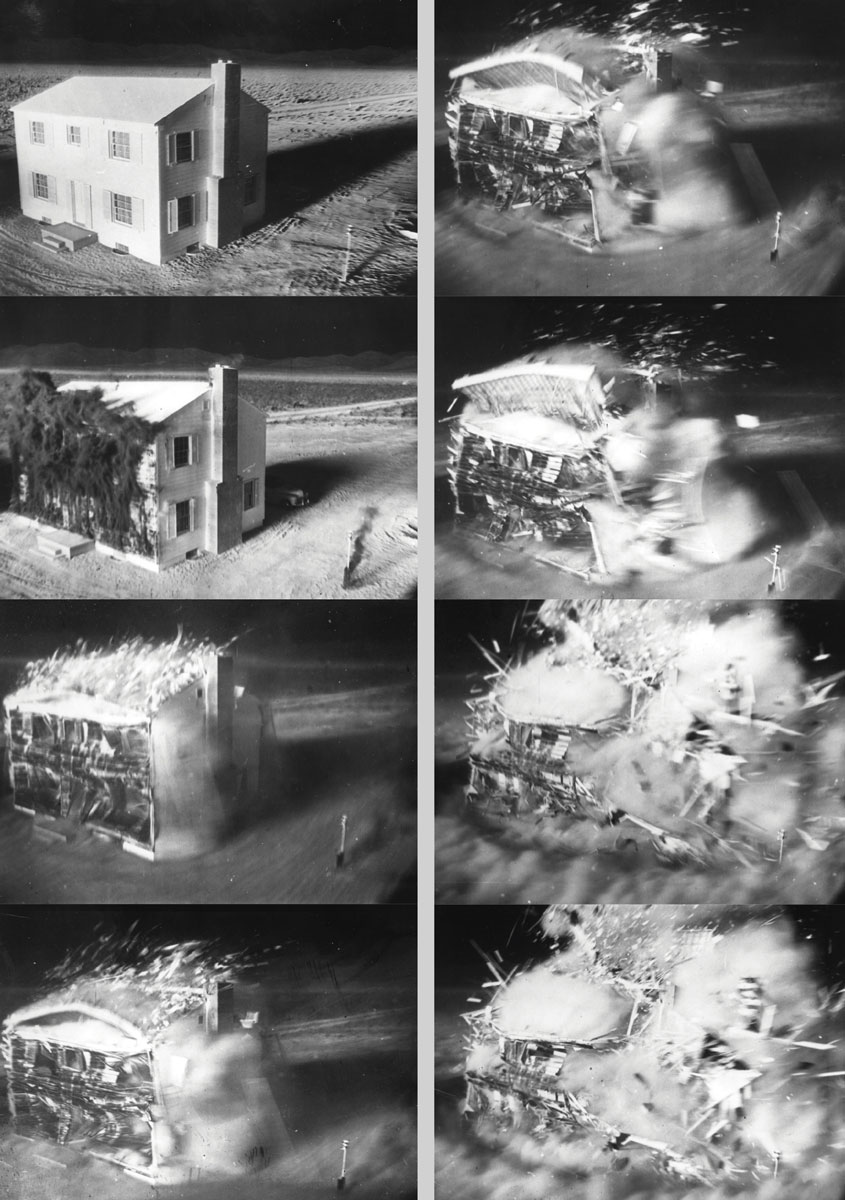
Driving us through the NTS, he points out details in a seamless history: “That’s Sedan Crater, the second-biggest in the US—part of the nonmilitary use-of-nuclear-explosives program. Astronauts trained there before going to the moon. That’s the Chemical Spill Test Facility, the only place in the country where you can create a major toxic accident to study how to clean it up. That’s the new Device Assembly Facility—miles of underground tunnels—we can’t go there.” I ask him when, in his experience, was the best moment to be working at the Test Site. “From 1962 to 1988,” he replies without hesitation. This era extended from the implementation of the above-ground nuclear test ban to the near-collapse of the industry, when revelations about the scope of environmental damage in places like Hanford, WA, Rocky Flats, CO, and Fernald, OH, brought heightened public suspicion and expanding new regulatory restraints. During this 26-year period, our guide says, nuclear weapons research paused only once. “JFK was assassinated on a test day,” he tells us, “and we postponed the ’shot’ for 24 hours but then got back to work.”
For this man, working at the Test Site provided access to the some of the best minds in the world, the scientists at the national laboratories (Los Alamos, Livermore, and Sandia). But it also demanded constant negotiation of the military mindset. Once, he simply pulled the detonating mechanism out of a nuclear device, stowed it in the trunk of his car, and drove away—putting anxious colonels and a multi-million dollar test on hold until he felt confident of its success. In the realm of Cold War masculinity, the buck stopped there. But it was also obviously so much fun. There are tales of midnight helicopter rides, hints at secrets he’s not allowed to share. His commentary constantly registers the pleasure of commanding earth-shattering technoscience, the satisfaction of having unlimited state resources to support it, and a race with a real enemy to give it meaning.
Our tour focuses on remnants of 1950s “weapons-effects tests”—tanks, bridges, and buildings deliberately blasted to see what would happen. He shows us, for example, a safe used in a 1957 test code-named Priscilla. The building was completely destroyed by the 37-kiloton explosion, but the safe and the money inside came through just fine. Next, we visit the waste storage site, an enormous trench filled with neatly stacked wooden boxes and metal drums—entering a nearby office building, we encounter a poster explaining how site workers mobilized to relocate a family of foxes living in the dump. Thus, while asking questions about radioactive waste and pondering the 100,000-year threat posed by some nuclear materials, we are presented with images of protected mammal babies and carefully documented signs of worker environmentalism. When we ask about contamination, our guide assures us that he has walked “every inch of this site” and suffered “no ill effects.” There is some contamination, he acknowledges, but it is contained and poses no public risk. The reference to radioactivity is countered with a story about a rattlesnake that bit into our guide’s cowboy boot and wouldn’t let go. He had the boots, snake included, bronzed. Dangers at NTS, in his presentation, are natural or international, but never nuclear or technoscientific.
Our final stop is the Apple II site, where in 1955 the US military built a “typical” American suburb for the sole purpose of dropping an atomic bomb on it. A fire station, a school, a radio station, a library, and a dozen homes were filled with everyday items (televisions, refrigerators, furniture, food, etc.), populated with white-skinned mannequins, and neatly annihilated. All that remains are a brick ruin and what looks like an abandoned wooden house, “a real fixer-upper” according to our guide. The only indicator of anything dramatic is that the chimney is cracked and wildly off-center, suggesting a powerful explosion but only hinting at the 29-kiloton bomb that detonated one mile away, vaporizing the rest of “survival town.” After the test, scientists held a feast in which they ate the food not incinerated—again, as our guide informs us, “suffering no ill effects.” In the serious play of the NTS, the meal was a kind of reverse last supper, where any signs of post-blast life were celebrated as absolute victory.
I ask our guide if the US could survive a nuclear war. “Oh, yes, I believe we could,” he replies, but later he seems unsure, acknowledging that nuclear war would be an “act of insanity—the end of everything.” This is the only ambiguity in a nearly perfect performance. The seamlessness of his narrative, in fact, registers his discipline: He neither confirms nor denies anything that makes the NTS suspect. In fact, his history is largely restricted to the era of above-ground nuclear testing (1951–1962), after which testing—and most of its visual consequences—went underground. This was, however, also the era of the most extreme environmental damage, when studies of blast-effects included experiments not only on banks, tanks, houses, and airplanes, but on soldiers ordered to march into fallout clouds, and on uninformed civilians. We know now that most of the continental US was affected by radioactive fallout from the NTS, contributing significantly to national thyroid cancer rates. But when I ask about fallout, our guide states simply, “that was before my time.”
And this, it seems to me, is desert modernism in its purest form, a profound belief in an unending and conceptually clean progress, but one made possible by strategic forgetfulness and sublimated technophilia. Just as the desert constantly threatens to overrun the Test Site, introducing weeds and blowing sand where shiny metal should be, the cosmology of the desert modernist requires a constant patrolling of the cognitive field to prevent ambiguity from taking root. As we leave the NTS, I ask about the future of nuclear weapons. “The Soviets—” our guide begins, then with a private half-smile, “I mean Russians—” he states are still dangerous, and concludes that developing nuclear weapons remains a means of protecting the “free world.” However, since his narrative cannot afford to acknowledge the local consequences of nuclear testing or assess the legacy of radioactive waste, the signs of nuclear nationalism revealed in our tour are not drawn from the current weapons complex—which is busily reinventing itself in a world with only one superpower. Instead, his performance is a carefully edited reiteration of mid-century nuclear culture, and by the end of our visit, it’s difficult not to conclude that nuclear weapons, despite our guide’s proclamations about the future, are now located in the past. We’ve seen no real evidence that they remain the foundation of US national security or a multi-billion-dollar-a-year operation, with 1997 budgets exceeding levels from the height of the Cold War. The vast desert landscape, combined with the aged quality of the buildings and the lack of any substantive evidence of ongoing science, minimize the scale of the nuclear project, and seemingly, its claim on the future. This may be a public relations tactic, but it might also be a structural effect of desert modernism. For how could those inhabiting the epicenter of the nuclear security state assess their own history? In order to do that, we must look more closely at the neighboring communities that live with the consequences of nuclear nationalism.
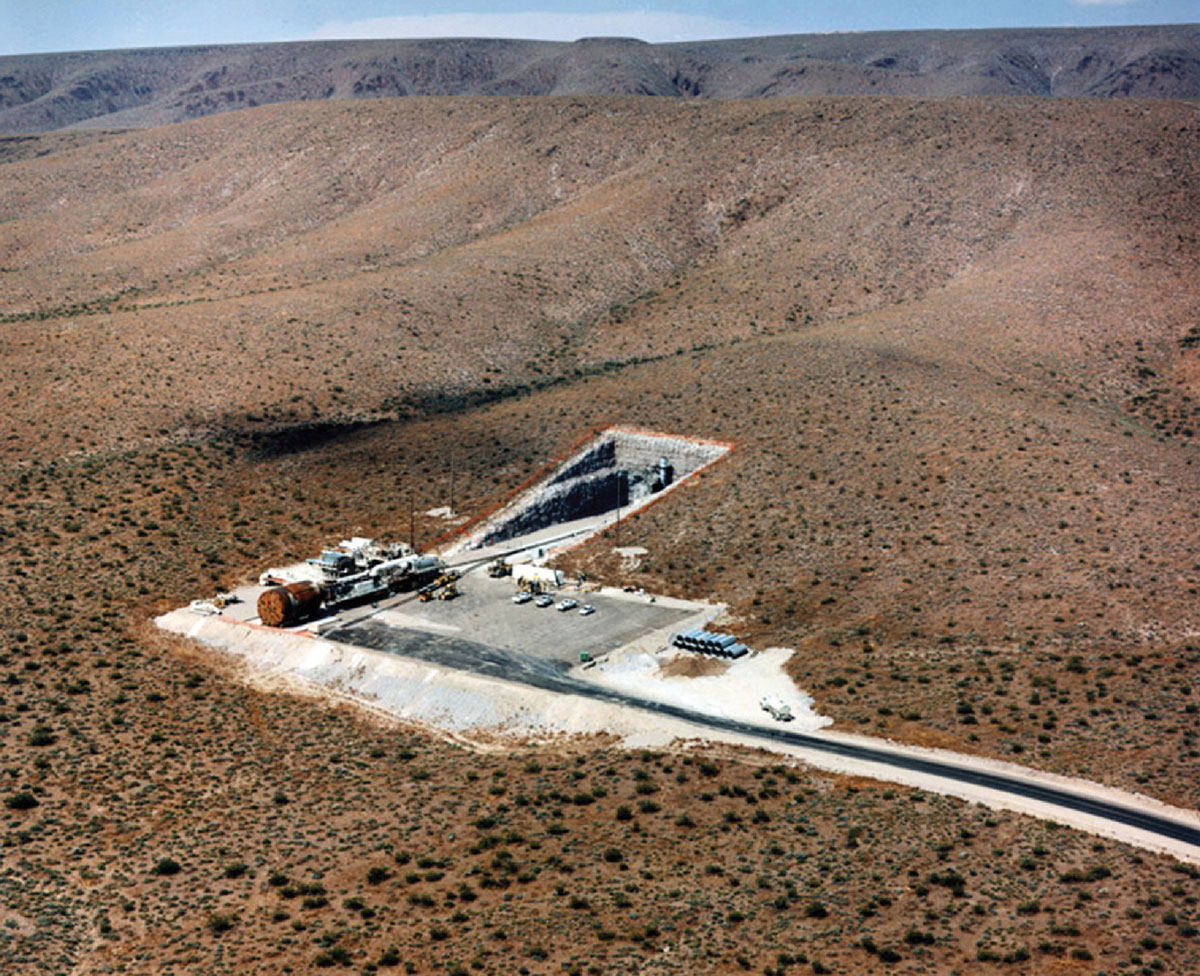
We arrive at Yucca Mountain for a safety lecture before plunging into a cave that U-turns for a mile through the mountain. Donning red hard-hats, goggles, and fluorescent orange earplugs, we strap emergency-breathing filters around our waists and are briefed on emergency procedures—in case of fire, we should use our filters even though they might scorch our lungs. Thus weighted down, we walk single file along railway tracks into the darkness. Deafening machine-noise mixed with the long shadows of artificial light and the smell of stale earth greet us. About 75 yards into the mountain, we enter a large chamber where we meet the tunnel engineer, a middle-aged man who wears his protective gear with practiced ease.
The engineer explains how waste is to be shipped to the site in barrels, where it will be stacked, and contingencies for retrieving specific barrels once stored. He is clearly nervous, aware of the intense politics around the Project, and he gains my sympathy, for he is not a public relations expert or a policy maker—he builds tunnels. He seems most comfortable providing technical information, and our attention moves to the rock walls and ceiling, which are covered with countless metal spikes secured by netting. We ask about them, and our engineer lights up. “Well, you see, there are two kinds of rock: good rock and bad rock. This is bad rock.” “Bad” rock crumbles and needs mechanical reinforcement, while “good” rock is internally reliable. Yucca Mountain has both good and bad rock, and is largely dependent on rock bolts to compensate for both. With alarming ease, in fact, all the debates about the scientific viability of Yucca Mountain as a waste storage site—the 20-plus years of acrimonious technical and political debate, the hundreds of thousands of pages of technical reports arguing potential risks and advantages, the 10,000-year plan—are all reduced to the power of the rock bolt. Brilliantly simple and reassuringly tangible, the rock bolt presents desert modernism in primordial form, for these bits of metal promise to hold the mountain together, to discipline the earth through millennia.
In the desert, however, one is never far from understanding that reality is mandated not only by official discourse, but by the cycles of wilderness. Yucca Mountain is and always will be a living organism, one that stands on several major fault lines, whose roots touch the water table that sources much of the Southwest. It is subject to tectonic shifts, erosion, and other planetary processes far beyond the reach of the rock bolt. I ask our engineer if the 10,000-year plan has affected his work in any way. “No,” he replies testily. Startled, I press on. “Do you ever feel that you’re building something for the ages here, like the pyramids?” “I don’t like to think about those kinds of things,” he replies. Then, looking directly in my eyes, he says, “I’ll guarantee this tunnel for 100 years. After that I hope they’ll have someplace else to put this stuff.” As the zeros drop off the 10,000-year master plan, the Yucca Mountain Project assumes the appearance of a national hoax, its confidence fractured unredeemably. Cold War apocalypticism—the fear of a sudden fiery end that propelled fission and ballistics science and created deterrence theory—assumed that the nation would end abruptly in an atomic flash, a prediction requiring radical action in the here and now. The Yucca Mountain Project, however, now assumes an eternal nation-state founded on the stability of “good rock,” and a government-to-be that will diligently uphold 20th-century laws and watch over 20th-century waste. At Yucca Mountain, the nostalgic desert modernism of the NTS formally confronts its future, and in that effort is expanded exponentially, to the point of self-contradiction and failure.
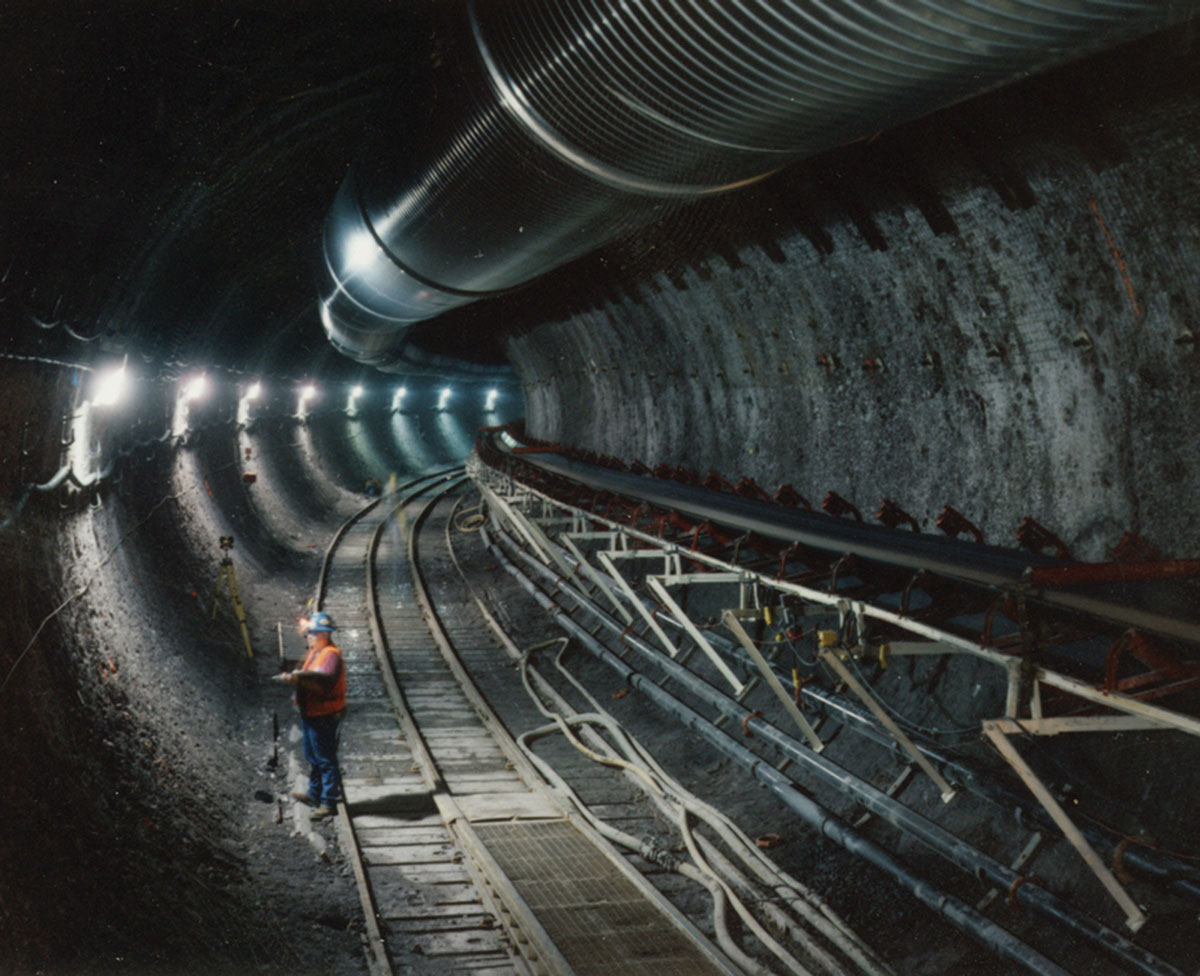
We start at the Little A’le’Inn Café, where the walls are covered with photographs of fuzzy disc-shaped things that might be spaceships, and talk turns to cover-ups and disinformation, why “They” are here and “what’s going on.” You can discuss government black budgets and black helicopters, or explore the latest theories on cattle mutilations and human abductions, secret genetic experimentation, and New World Orders. Who is really behind the United Nations, the International Monetary Fund, the Trilateral Commission? Was the Cold War really a battle with the Soviets or merely a way for both countries to arm against invading extraterrestrials? Is the current fascination with UFOs a giant campaign to hide the Truth, or is the government preparing us for the news that They have been here a long, long time? Above all—what’s coming next?
While we eat lunch, a conspiracy theorist takes center stage, singing country & western songs and playing an electric organ. A waitress joins him. They’re having a good time, and between tunes, he introduces himself. I recognize him, having seen one of his self-financed videos on UFOs. On tape, he argues that UFO sightings are masterminded by an “international cabal” and warns that sometime in the late-1990s a “major UFO incident” will be staged at Area 51 as a carefully planned media distraction to enable a global takeover. Today, he has some new information, an 11-by-14 inch aerial image of a parking lot surrounded by trees and containing several olive-green army vehicles and one bright yellow Ryder moving van. “This photograph was taken in April of 1995 at a military base near Oklahoma City, a few days before the Oklahoma bombing.” He shows another picture of the same lot, same jeeps, but no van. “This was taken a few days later. Now, I think this is very interesting. What is a Ryder van doing in a military parking lot? I’m not saying the government was directly involved, but I think it’s interesting. Before the bombing of the Murrah Federal Building there is a Ryder van on the military base, and after, it is gone. I think this is very significant.” He drifts back to his music, leaving us to contemplate what it would mean if, in fact, a secret organization with access to US Army facilities had bombed a US federal building and implicated a white supremacist group as part of a calculated plan to take over the world. Conspiracy theorists are a necessary by-product of the desert modernism pursued by the national security state. The people of Rachel live only a few miles from Area 51—some residents have worked there and trace their current health problems to on-the-job toxic exposure. They also know that, for years, one of the best and most readily available photographs of Area 51 was made by a Soviet surveillance satellite. Yet, despite this experiential knowledge and a significant presence in popular culture (for example, in the film Independence Day), the US Air Force will only acknowledge an “operational presence” in the Groom Lake area. Officially, Area 51 does not exist.[4]
For Rachel’s residents, nuclear modernity and its aftermath have thus become a convoluted open secret, requiring those who want to “live free” to track the signs of a military-industrial complex that impinges upon their lives in visceral ways. Excluded from the system but well aware of its effects—mysterious illnesses, invisible forms of surveillance, lights in the night sky—conspiracy theorists mobilize to fill the gaps. A half-century of government policy to “neither confirm nor deny” questions about nuclear nationalism has produced a proliferating discursive field where citizens must rely on their imaginations. In this way, the café conversations present a displaced mirror-image of nuclear nationalism, for the programming at the NTS, Yucca Mountain, Area 51 and life in Rachel all assume that the world is ultimately knowable, that there are no coincidences, and that careful observation of everyday life can reveal the hidden master-narrative of existence. This attention to the scripting of appearances in the desert West, however, now exceeds the national security state, having evolved into a resilient new kind of American expressive culture simultaneously apocalyptic, narcissistic, sensational.
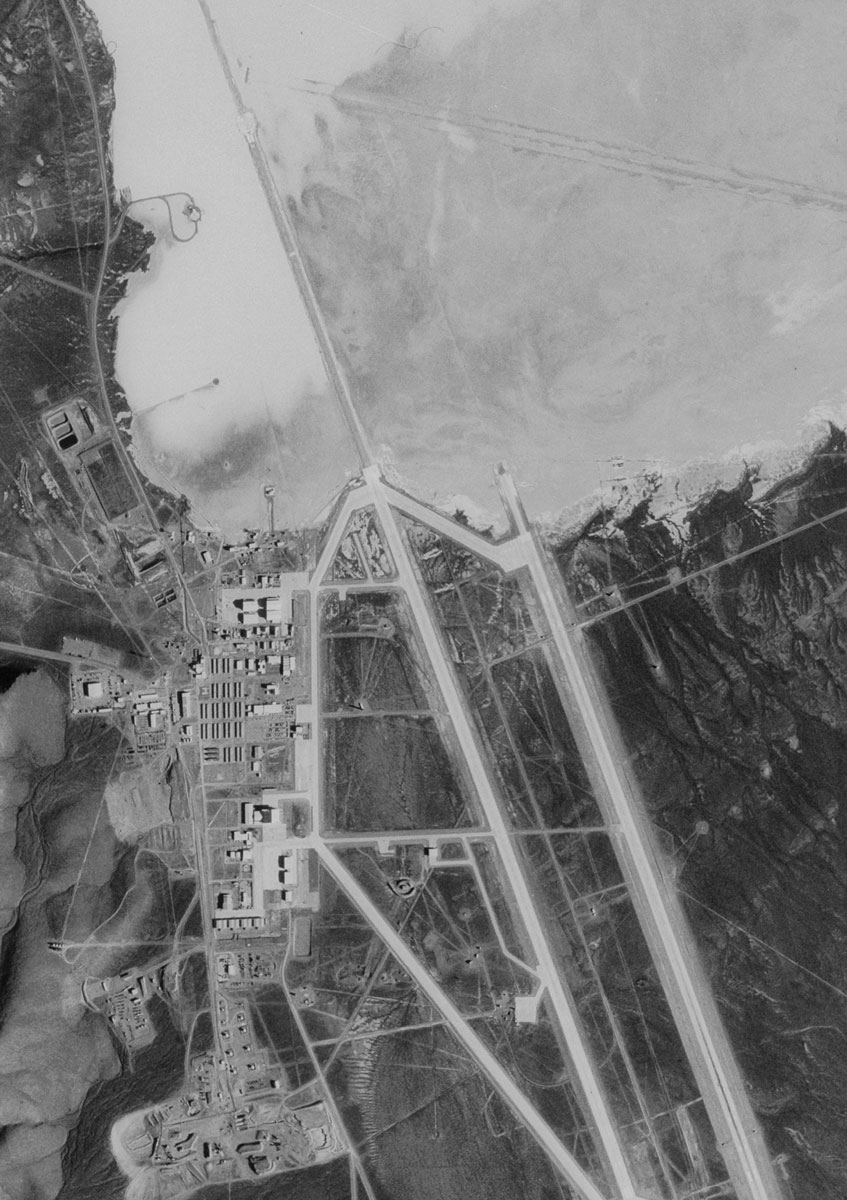
One of the most popular attractions in town, the Liberace Museum houses the entertainer’s famously sequined costumes, his jewel-encrusted pianos and candelabras, custom-built cars, and other mementos from a career that opens a unique window into the hypermasculinity of the Cold-War American West. Indeed, Liberace, Las Vegas, and the NTS were coincident from the beginning. The NTS opened in 1951, and by the mid-1950s the two biggest shows in Nevada were nuclear explosions and Liberace, who earned $50,000 a week at the new Riviera casino, performing his signature pastiche of high and low musical genres in a black tuxedo studded with 1,328,000 sequins. A favorite pastime of the era was to take a cocktail up to the top of a casino in the morning, to search the northern horizon for a flash of light or a mushroom cloud and toast America’s superpower ascendancy.
Like JFK, that other icon of Cold War masculinity, Liberace drew his fame in part from a public fascination with his sexuality that included its explicit constructedness and which encouraged audiences to participate in that construction. At a moment when to be gay was to occupy the cultural position of the Communist, subject to McCarthyite assaults, Liberace successfully sued newspapers that questioned his heterosexuality, even as he lived with male partners. His charm derived from his exaggerated scripting of appearance, which enabled fans to enjoy his overt artistic and class transgressions and mimetic gender play without feeling threatened. Thus, one need not be a conspiracy theorist to wonder at the synchrony that brought down two mid-century icons on the same November night in 1963. As news of Kennedy’s assassination swept the nation, Liberace collapsed in the midst of his memorial concert, poisoned by dry-cleaning chemicals accumulated in his fabulous costumes. Toxic shock took him into kidney failure. Unconscious and on life support, he was given last rites and thought lost.
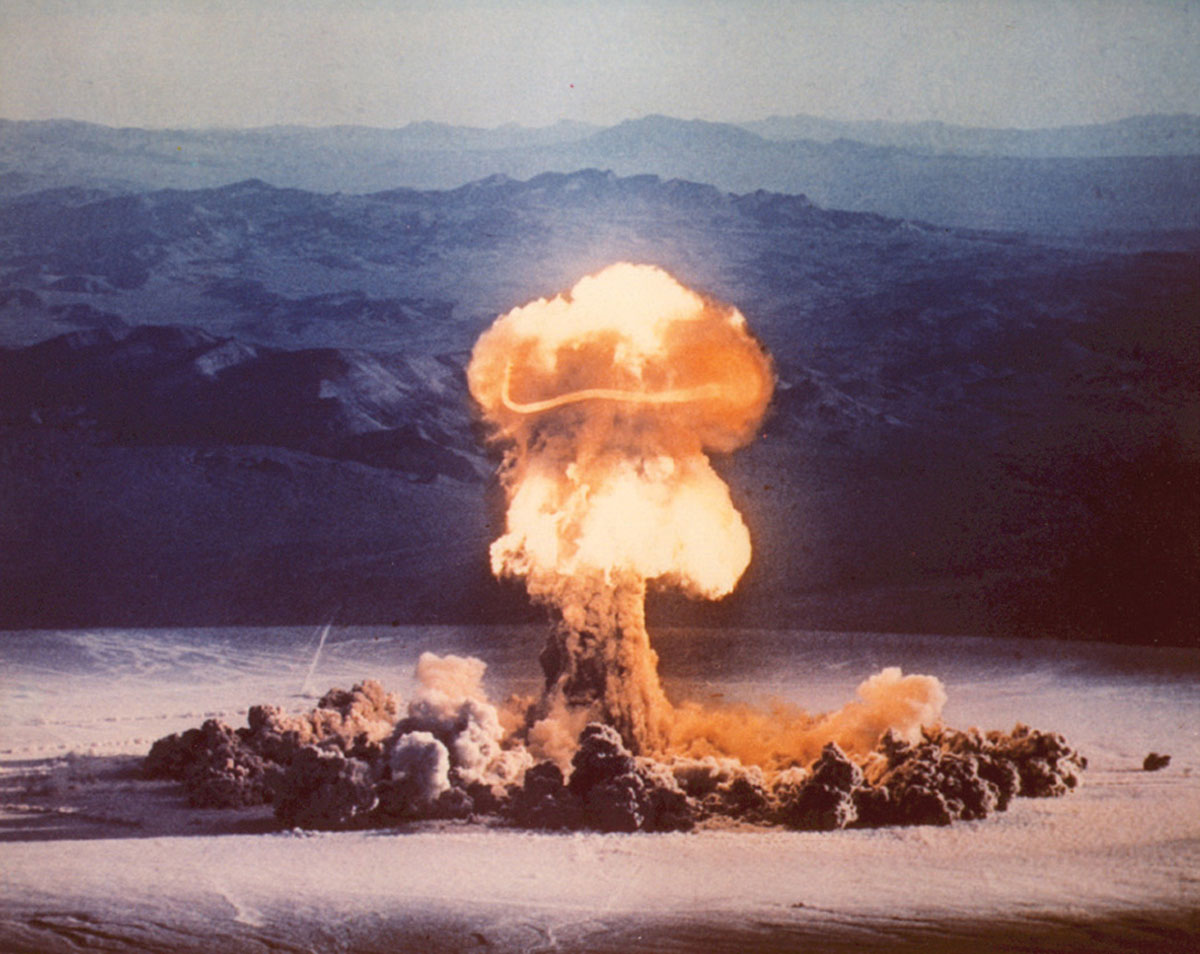
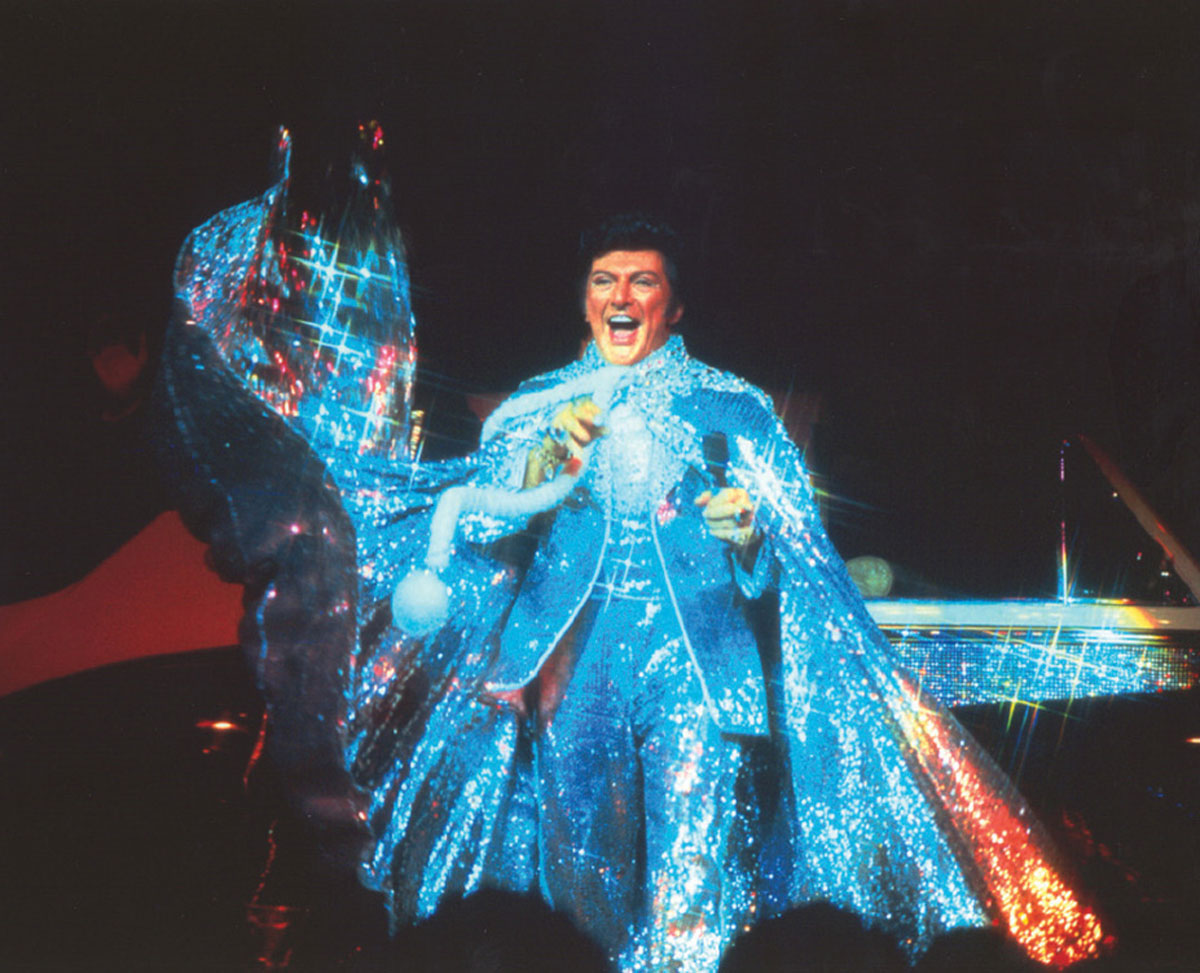
From the 100,000-year half-life of the waste at Yucca Mountain to the poisons collected in Liberace’s sequined suits, desert modernism is, as I’ve suggested, necessarily blind to its own excess. True to form, Liberace claimed later that in a vision a white-robed nun not only healed him, but actually blessed his love of opulent display. Indeed, after his brush with death, he sought to reinvent himself with each new costume, and was soon fighting an arms race of his own with entertainers like Elvis Presley for command of the most over-the-top performance. By the 1970s, his sequined outfits had grown to more than 200 pounds, making each night on stage a delicate balancing act. In this light, Liberace’s Vegas career might be taken as an index for certain aspects of Cold War culture, in which the hyperproduction of nuclear weapons—70,000 in all, enough to destroy every major city on the planet dozens of times over—also registered a national fascination with excess and exhibitionism, and involved a precarious dance with death. It is important to remember that after Hiroshima and Nagasaki, the US nuclear arsenal was officially designed never to be used. It was intended merely to display American might. The explosions at the NTS and the elaborate concealment of Area 51 were never merely tests or secrets, they were expressive national performances. But while this careful scripting of appearances seemed to deny the possibility of a future on any terms but those of the desert modernist, it left accumulating toxic legacies in its wake. Thus, even as we wonder today at the danger and discipline required to perform in a life threatening mass of sequins, the nuclear future at Yucca Mountain maintains its radioactive glow.
- For a remarkable introduction to the Nevada Test Site, see Center for Land Use Interpretation, The Nevada Test Site: A Guide to America’s Nuclear Proving Ground (Los Angeles: The Center for Land Use Interpretation, 1996), and Kathleen Stewart, “Bitter Faiths,” in Technoscientific Imaginaries: Conversations, Profiles, and Memoirs, ed. George Marcus (Chicago: University of Chicago Press, 1994). For historical analysis of above-ground nuclear testing, see Richard L. Miller, Under the Cloud: The Decades of Nuclear Testing (New York: Free Press, 1986), Philip L. Fradkin, Fallout: An American Nuclear Tragedy (Tucson: The University of Arizona Press, 1989), and Barton C. Hacker, Elements of Controversy: The Atomic Energy Commission and Radiation Safety in Nuclear Weapons Testing, 1947–1974 (Berkeley: University of California Press, 1994). For studies of communities suffering health effects from work at the NTS, see Carole Gallager, American Ground Zero: The Secret Nuclear War (Cambridge: MIT Press, 1993) and Valerie L. Kuletz, The Tainted Desert: Environmental and Social Ruin in the American West (New York: Routledge, 1998). For an assessment of Cold War human radiation experiments, see Advisory Committee on Human Radiation Experiments, The Human Radiation Experiments: Final Report of the President’s Advisory Committee (New York: Oxford University Press, 1996). For a 10,000-page, county-by-county assessment of radioactive fallout and its impact on national thyroid cancer rates, see The National Cancer Institute, “Estimated Exposures and Thyroid Doses Received by the American People From Iodine-131 in Fallout Following Nevada Atmospheric Nuclear Bomb Tests,” 1997. For the environmental impact of military nuclear technology, see International Physicians for the Prevention of Nuclear War and the Institute for Energy and Environmental Research, Radioactive Heaven and Earth: The Health and Environmental Effects of Nuclear Weapons Testing In, On, and Above the Earth (New York: Apex Press, 1991). For a detailed accounting of the nearly $6 trillion spent on US nuclear weapons in the 20th century, see Stephen I. Schwartz, ed., Atomic Audit: The Costs and Consequences of U.S. Nuclear Weapons Since 1940 (Washington, D.C.: Brookings Institution Press, 1998).
- On 23 July 2002, President George W. Bush approved Yucca Mountain as the nation’s primary commercial nuclear waste repository. Numerous pending lawsuits notwithstanding, Yucca Mountain will open in 2010. See Kuletz, The Tainted Desert; Michael Taussig, Defacement: Public Secrecy and the Labor of the Negative (Stanford: Stanford University Press, 1999); and Daniel Rosenberg, “No One Is Buried in Hoover Dam,” in Modernism, Inc.: Body, Memory, Capital, eds. Jani Scandura and Michael Thurston (New York: New York University Press, 2001).
- On Area 51 conspiracy theories, see Susan Lepselter’s “Why Rachel Isn’t Buried at her Grave: Ghosts, UFOs, and a Place in the West,” in Susan Harding and Dan Rosenberg, eds., Histories of the Future (Durham: Duke University Press, forthcoming) as well as David Darlington, Area 51: The Dreamland Chronicles (New York: Henry Holt and Company, 1997). See Kathleen Stewart and Susan Harding, “Bad Endings: American Apocalypsis,” Annual Review of Anthropology 28 (1999): 285–310 on American apocalypticism, and Mark Fenster, Conspiracy Theory: Secrecy and Power in American Culture (Minneapolis: University of Minnesota Press, 1999) on conspiracy theory. See Eileen Welsome, The Plutonium Files: America’s Secret Medical Experiments in the Cold War (New York: The Dial Press, 1999) for discussion of covert human experimentation during the Cold War; Spencer R. Weart, Nuclear Fear: A History of Images (Cambridge: Harvard University Press, 1988) for a cultural history of nuclear anxiety; and Daniel Patrick Moynihan, Secrecy: The American Experience (New Haven: Yale University Press, 1998) for an analysis of U.S. secrecy since World War II. See Joseph Masco, “Lie Detectors: On Secrets and Hypersecurity in Los Alamos,” Public Culture 14, no. 3 (2002): 441–467 for a discussion of post–Cold War secrecy and security concerns within the US nuclear complex.
- In September 2001, President George W. Bush renewed a Clinton Administration executive order exempting an “unnamed” Groom Lake Air Force facility from environmental laws. This rule has been justified under national security protocols, but also has the effect of suppressing lawsuits filed by former employees regarding toxic exposure. In other words, the state can now argue that since the base does not officially exist, how could anybody have worked there, let alone been poisoned on the job?
- Biographical information on Liberace is based on the presentation at the Liberace Museum, as well as Liberace: An Autobiography (New York: G. P. Putnam’s Sons, 1973), and Bob Thomas, Liberace: The True Story (New York: St. Martin’s Press, 1987). For analysis of Cold War gender roles, see Alan Nadel, Containment Culture: American Narratives, Postmodernism, and the Atomic Age (Durham and London: Duke University Press, 1995). For policy assessment of US security clearances and sexual orientation, see US General Accounting Office, Security Clearances: Consideration of Sexual Orientation in the Clearance Process (Washington, D.C., 1995). For more on Las Vegas and the culture of above-ground nuclear testing at the NTS, see Constandina A. Titus, Bombs in the Backyard: Atomic Testing and American Politics (Reno and Las Vegas: University of Nevada Press, 1986).
Joseph Masco teaches anthropology at the University of Chicago, where he writes about technology, politics, and aesthetics.